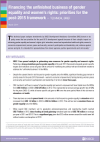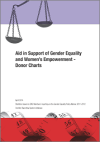FUNDAR 37
This note provides an overview of existing gender equality markers and reviews issues relating to the tracking and monitoring of investments related to gender equality and women’s empowerment.
This technical paper analyses investments by OECD Development Assistance Committee (DAC) donors in six policy areas that are priorities for the post-2015 development agenda because of their catalytic impact on achieving gender equality and women’s rights: girls’ education; sexual and reproductive he
This toolkit follows the transfer of public funds from central to local governments until they reach users such as schools and clinics. It explains how a public expenditure tracking system operates and how it can benefit marginalized groups.
The guidance note sets out commom principles and standards for gender equality markers systems that track and report on allocations and expenditures for gender equality and women's empowerment.
The ITC/ILO gender marker is a one-digit code (on a 0 to 3 scale) used by ITC to assess ;whether or not ITC/ILO ;training activities are designed in a gender-sensitive way in order to address the needs of women and men as ultimate beneficiaries of development actions.The application of the marker i
This report draws on the ten indicators including global indicator on gender equality of the Global Partnership monitoring framework. This report provides a first global snapshot of the state of play in implementing selected Busan commitments. In the midp
The third report in a new research series on resources for women's rights organizing from the Association for Women's Rights in Development, this publication presents the results of our mapping of new donors making major commitments to work with "women and girls", to better understand this trend and



